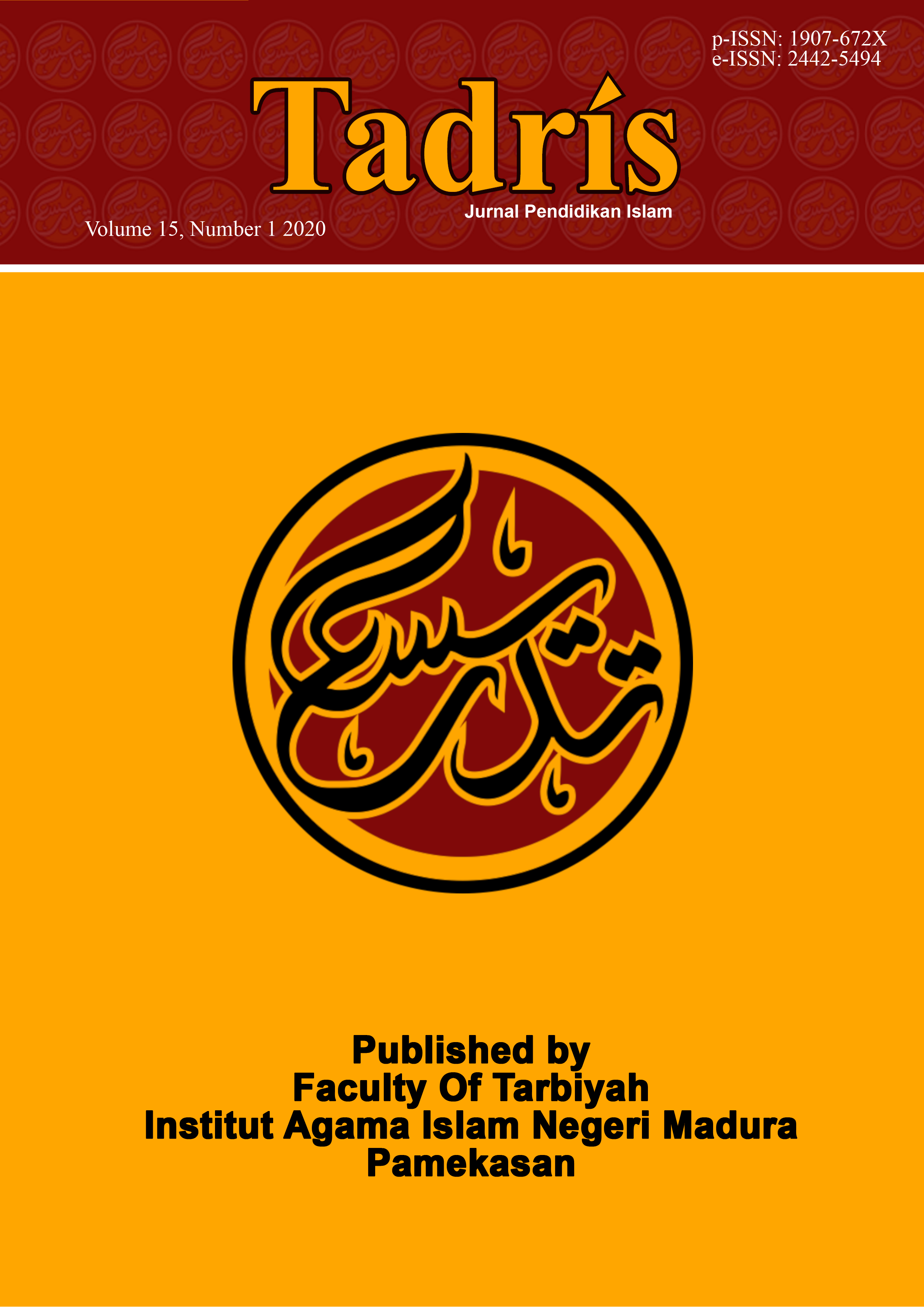Implementasi Classical Conditioning dalam Pembelajaran PAI
 Abstract views: 2398
,
Abstract views: 2398
,
 PDF downloads: 7278
PDF downloads: 7278
Abstract
SMAN 1 Teladan Yogyakarta in learning Islamic religious education uses behavioristic theory known as classical conditioning. This study aims to determine the implementation of classical conditioning in the learning of Islamic religious education at SMAN 1 Teladan Yogyakarta and the factors that influence it. This study supports qualitative research with a case study approach. Data collection is done by using observation and interview methods. The results of the study showed that the application of classical conditioning in PAI learning was carried out through several stages, namely (1) making the classroom atmosphere comfortable. The stages carried out are giving freedom to students in expressing opinions during discussions, tucking in intermezo in the explanation of the material, occasionally using English in the explanation of the material, and the use of LCD in learning. (2) assigning tasks is continuous. Assignments given in the form of group discussions and cult. Students perform a cult when the teacher prepares teaching material. In addition the stimulus makes students become active in learning. The factors that influence it are the teacher's factor, the teacher has the ability to understand student psychology so that he understands the theory or the right method to use. Student factors, students have a sense of responsibility for the tasks given, and the attitude of complementarity in the cult task. Institutional factors, institutions or schools that support in terms of vision and mission and school policies.
Downloads
References
Zamzani, Muh. Rodhi “Penerapan Reward and Punishment dalam Teori Belajar Behaviorisme”. dalam Jurnal Ta’limuna. Vol. 4 No 1. Maret, 2015.
Zulhammi. ”Teori Belajara Behavioristik dan Humanistik dalam Perspektif Pendidikan Islam”. dalam jurnal Darul Ilmi. Vol. 3 No 1. Januari, 2015.
Hill, Winfred F. Theories of Learning: Teori-Teori Pembelajaran Konsepsi, Komparasi, dan Signifikasi. Cet. VII; Bandung: Nusa Media, 2012.
Assegaf, Abd. Rachaman. Filsafat Pendidikan Islam. Cet. III; Jakartta: Raja Grafindo Persada, 2014.
Baharu, Hasan. “Pengembangan Media Pembelajaran PAI Berbasis Lingkungan Melalui Model Assure”. dalam jurnal Cendekia. Vol. 14 No. 2. Juli-Desember, 2016.
Haslinda. “Classical Conditioning”. dalam Jurnal Network Media. Vol. 2 No. 1. Februari, 2019.
Huda, Muhammad Misbahul. “Kolaborasi Teknik Insight, Modelling, Classical Conditioning, sebagai Strategi Konselor dalam Pendidikan Karakter”. dalam Jurnal Psikopedagogia. Vol. 6 No. 1. Juni, 2017.
Nahar, Novi Irwan. “Penerapan Teori Behavioristik dalam Proses Pembelajaran”. dalam Jurnal Nusantara. Vol.1. Desember, 2016.
Nurhidayati, Titin. “Implementasi Belajar Ivan Petrovich Pavlov (Classical Conditioning) dalam Pendidikan”. dalam Jurnal Falasifa. Vol. 3 No. 1. Maret, 2012.
Rusuli, Izzatur. “Refleksi Teori Belajar Behavioristik dalam Perspektif Islam”. dalam Jurnal Pencerahan. Vol. 8 No. 1. Juli-Desember, 2014.
Bahri, Samsul. “Paradigma Pembelajaran Conditioning dalam Pespektif Pendidikan Islam”. dalam Jurnal Tadris. Vol 12 No 2 Desember 2017.
Pratama, Yoga Anjas. “Relevansi Belajar Behaviorisme dan Terhadap Pendidikan Agama Islam”, dalam Jurnal Al-Thoriqaah. Vol 4 No 1. Januari-Juni, 2019.
Sakinah, Umul. ”Konseling Behavioristik dalam Membentuk Perilaku Mandiri Merawat Diri pada Tunagrahita”. dalam Jurnal Hisbah. Vol. 15 No 1. Juni, 2018.
Syah, Muhibbin. Psikologi belaja. Jakarta: Rajawali Pers, 2012.
Ramayulis. Ilmu Pendidikan Islam. Cet. XIII; Jakarta: Kalam Mulia, 2018.
Siregar, Eveline. Teori Belajar dan Pembelajaran. Bogor: Penerbit Ghalia Indonesia, 2014.
Abdriyani, Fera. “Teori Belajar Behavioristik dan Pandangan Islam tentang Behavioristik”. dalam Jurnal Syaikhuna. Ed. 10 No 2. Maret, 2015.
Harianto, Suyono dan. Belajar dan Pembelajaran. Bandung: Remaja Rosdakarya, 2011.
Copyright (c) 2020 TADRIS: Jurnal Pendidikan Islam

This work is licensed under a Creative Commons Attribution-NonCommercial 4.0 International License.
The journal operates an Open Access policy under a Creative Commons Non-Commercial 4.0 International license. Authors who publish with this journal agree to the following terms:
- Authors retain copyright and grant the journal right of first publication with the work simultaneously licensed under a
 Commons Attribution-NonCommercial 4.0 International License
Commons Attribution-NonCommercial 4.0 International Licensethat allows others to share — copy and redistribute the material in any medium or format, and adapt — remix, transform, and build upon the material.
- Authors are able to enter into separate, additional contractual arrangements for the non-exclusive distribution of the journal's published version of the work (e.g., post it to an institutional repository or publish it in a book), with an acknowledgement of its initial publication in this journal.
- Authors are permitted and encouraged to post their work online (e.g., in institutional repositories or on their website) prior to and during the submission process, as it can lead to productive exchanges, as well as earlier and greater citation of published work (see The Effect of Open Access).














